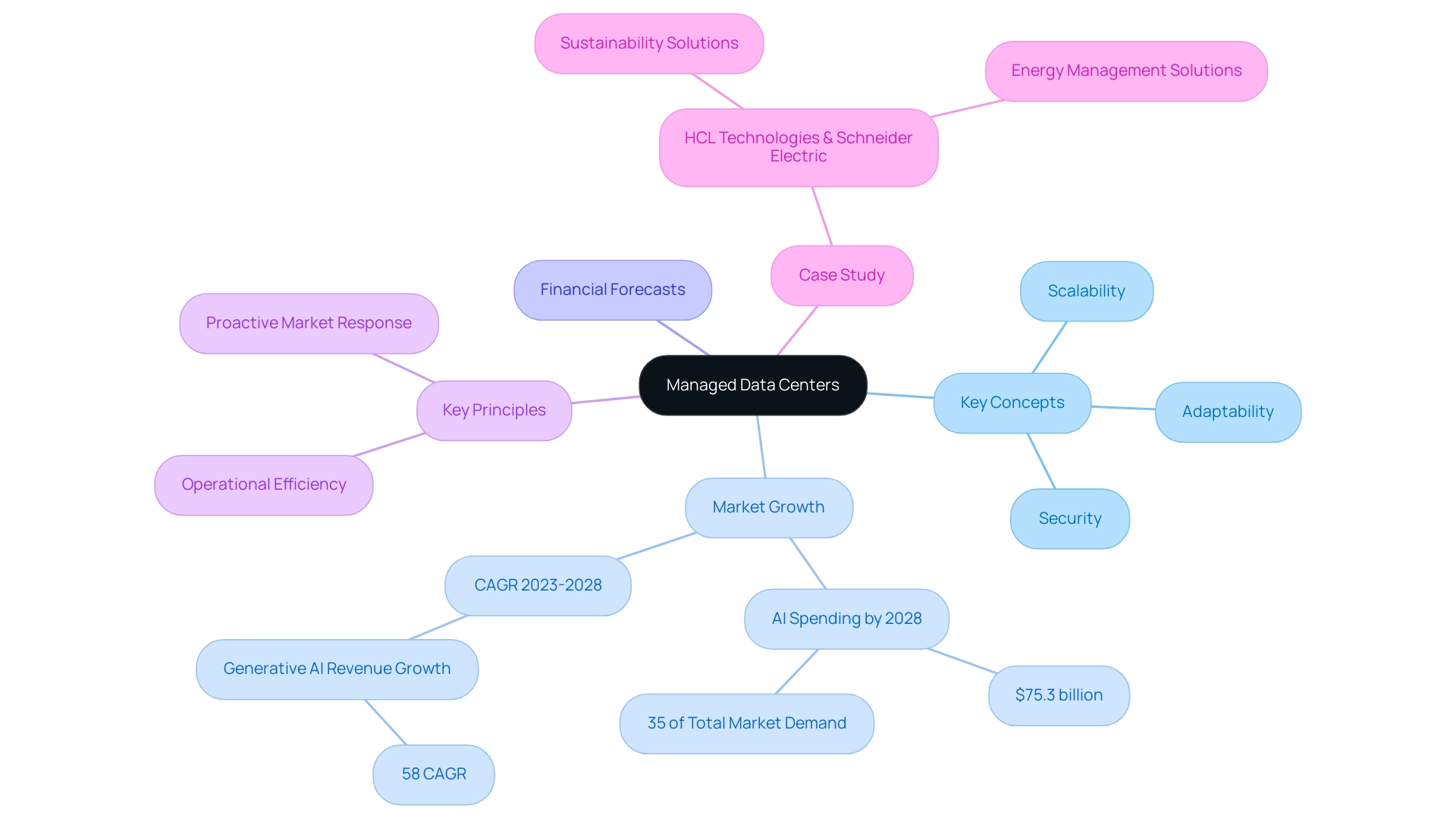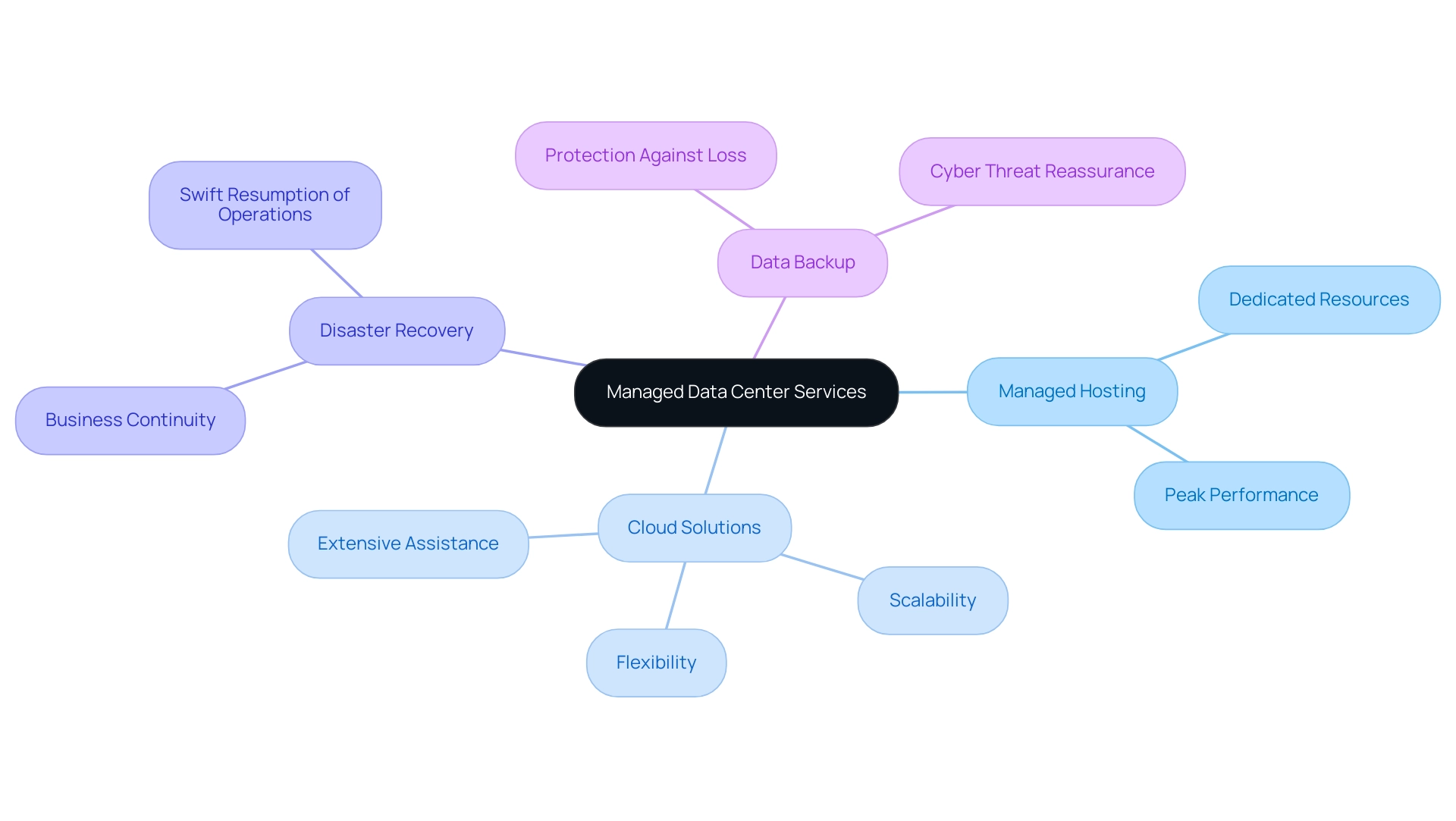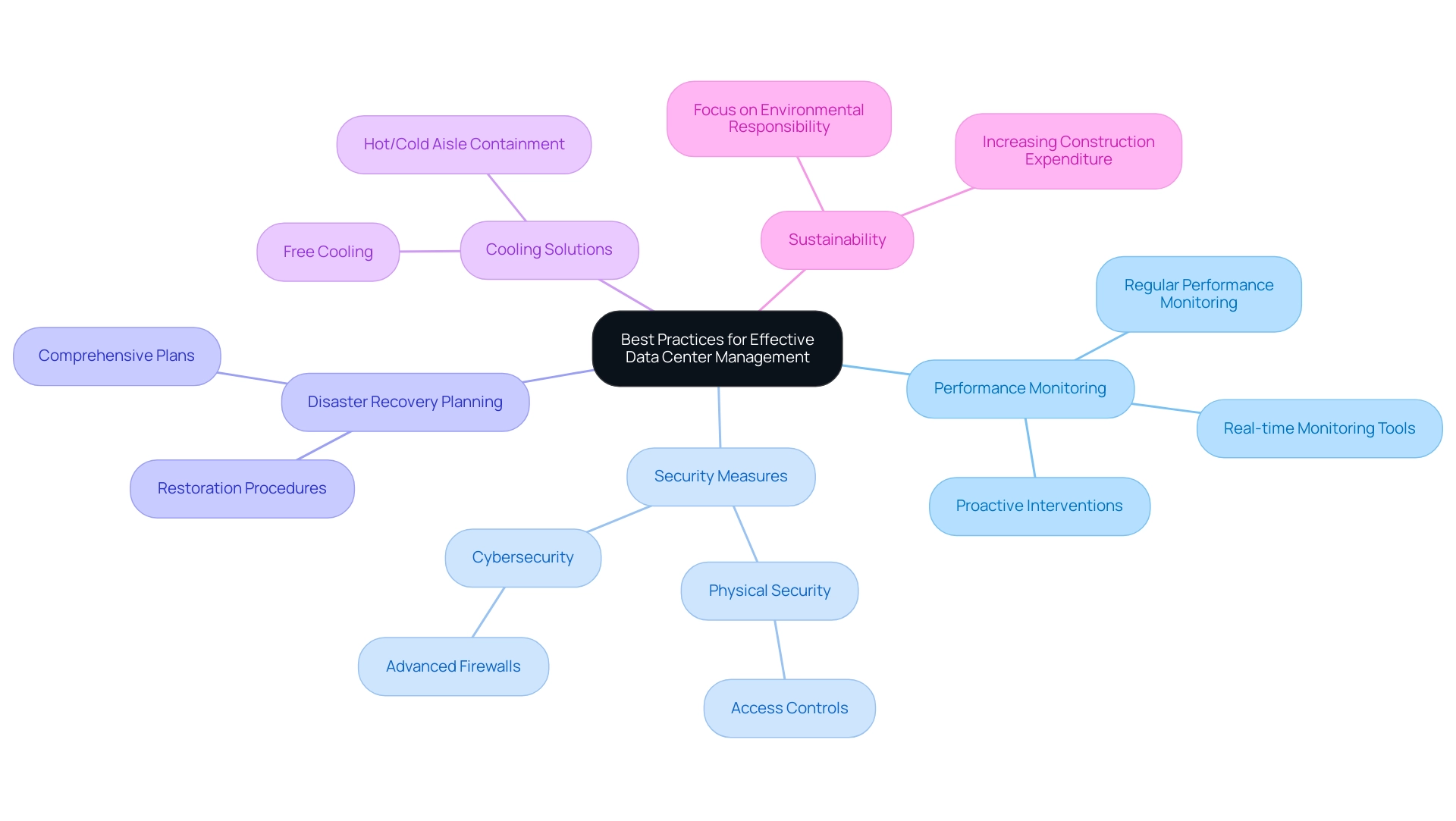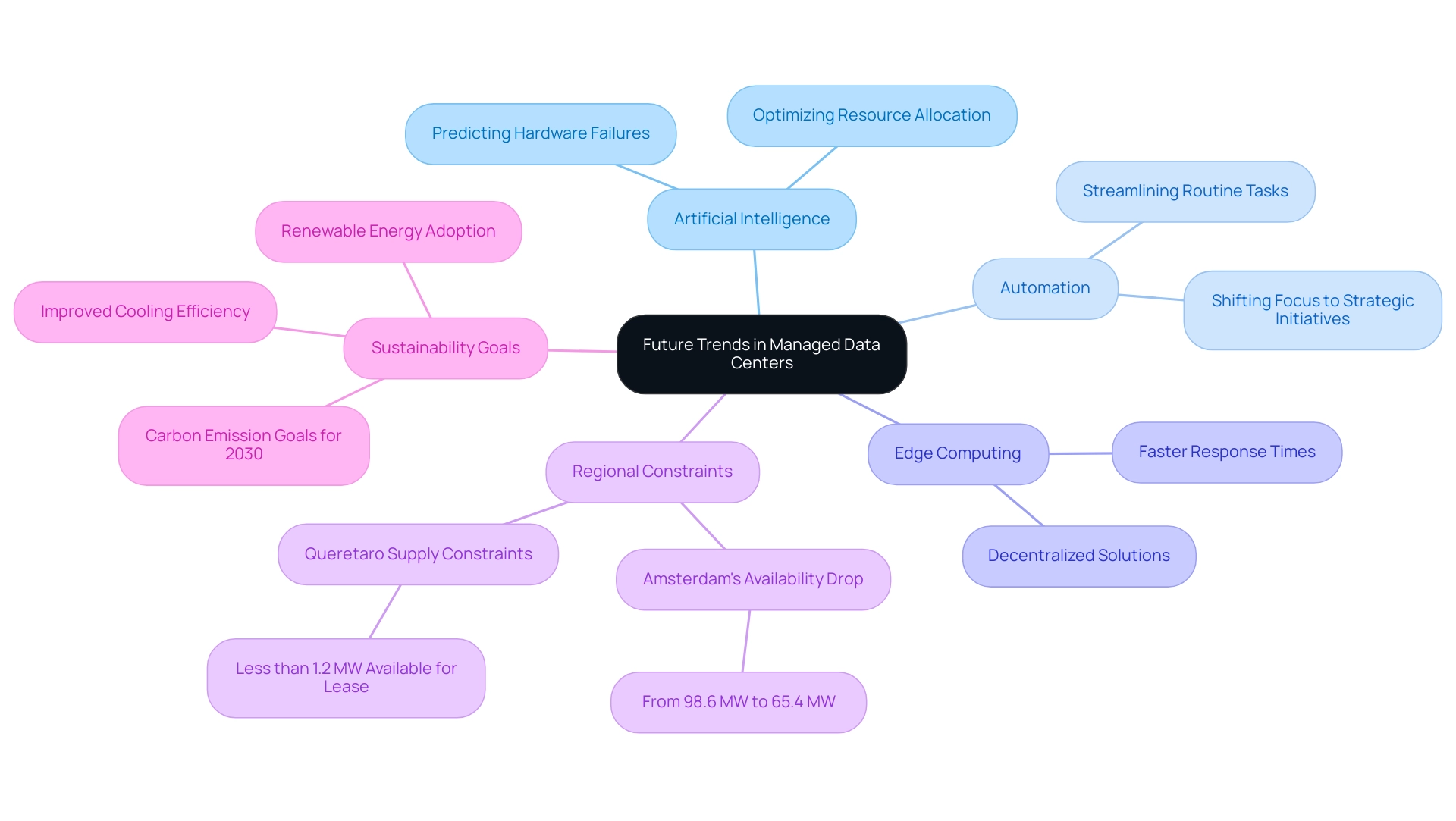Introduction
As the digital landscape continues to evolve, managed data centers are emerging as vital components of contemporary business infrastructure. These facilities, characterized by their comprehensive management of physical resources, security, and maintenance by specialized service providers, enable organizations to focus on their core operations while effectively outsourcing data management.
The significance of managed data centers is underscored by a projected surge in market spending, driven largely by advancements in artificial intelligence, which is anticipated to reshape industry dynamics in the coming years. With key concepts such as scalability, flexibility, and security at the forefront, businesses are finding themselves better equipped to navigate the complexities of data management.
This article delves into the essential aspects of managed data centers, exploring their services, associated challenges, best practices for effective management, and future trends that promise to redefine operational efficiency and sustainability in this rapidly advancing sector.
Defining Managed Data Centers: Key Concepts and Importance
Operated facilities are a crucial asset in the technological framework of contemporary enterprises, serving as sites that are possessed and run by service providers accountable for the complete oversight of physical infrastructure, security, and upkeep. This model enables organizations to outsource their management needs while retaining oversight of their assets. The increasing significance of these facilities is highlighted by the expected rise in spending on computing hubs propelled mainly by progress in artificial intelligence, estimated to hit $75.3 billion by 2028—representing around 35% of the overall market demand.
Moreover, income from generative AI within server facilities is anticipated to increase at an impressive 58% CAGR from 2023 to 2028, emphasizing the transformative effect of AI on the sector. As Pankaj Sachdeva aptly states,
And the nature of those workloads is rapidly transforming where and how information facilities are being designed and operated.
Additionally, the Asia-Pacific region is experiencing a notable increase in pricing, with Singapore demanding over US$300 per kW, reflecting strong demand and market dynamics.
Key principles intrinsic to a managed datacenter encompass scalability, adaptability, and security—factors that are becoming ever more crucial in today’s rapidly changing technological environment. The ability to provide strong infrastructure solutions that adjust effortlessly to expansion and evolving needs enables companies to focus on their primary strengths, freeing them from the challenges of information oversight. This strategic shift not only enhances operational efficiency but also positions organizations to respond proactively to market dynamics, ultimately facilitating business success.
A relevant case study demonstrating innovation in this sector is the partnership between HCL Technologies and Schneider Electric, which emphasizes creating energy management solutions for managed datacenters in the Asia-Pacific area. This collaboration seeks to improve energy efficiency and sustainability in facility operations, reflecting a growing trend towards environmentally responsible practices.

Exploring Managed Data Center Services: Solutions and Benefits
Managed datacenter offerings encompass a diverse array of solutions designed to optimize IT operations, including managed hosting, cloud solutions, disaster recovery, and data backup. Each of these offerings provides unique advantages that can significantly enhance organizational performance. Managed hosting, for instance, provides dedicated resources tailored for peak performance, ensuring that applications run smoothly without the overhead of shared environments.
One satisfied client remarked, 'Using STS Consulting Group helped me save weeks of work. Their delightful level of quality and support is consistent and unique.' This testimonial highlights the efficiency gained through managed hosting. On the other hand, cloud solutions introduce flexibility and scalability, allowing organizations to adjust resources in real-time based on fluctuating demands.
Another client noted, 'STS Consulting Group was the missing piece to my puzzle. From start to finish, they resolved every issue and assisted us in reaching our objectives in the most professional manner possible,' highlighting the extensive assistance offered through cloud solutions. Furthermore, disaster recovery solutions are critical for maintaining business continuity during unexpected disruptions, ensuring operations can swiftly resume.
Backup solutions play a crucial role in protecting against loss, offering reassurance in the face of rising cyber threats. By leveraging these comprehensive solutions, organizations can not only improve operational efficiency but also achieve substantial cost reductions compared to maintaining on-premises infrastructure. Significantly, the cloud IT infrastructure expenditure is expected to attain an impressive $133.7 billion by 2026, indicating a strong market trend toward adopting these solutions.
Additionally, the semiconductor market has demonstrated significant growth, with revenue anticipated to rise, further highlighting the economic significance of effective information management solutions. In Rio de Janeiro, the information facility market has steadily grown, providing important hyperscale advancements that emphasize energy supply growth, highlighting present trends in managed facilities. As highlighted by FDCA, facilities in Finland benefit from over 8,000 hours of free cooling each year due to the arctic climate, showcasing how geographical advantages can further enhance operational efficiencies.
In this changing environment, organizations that incorporate a managed datacenter are better equipped to improve their overall data security stance and promote strategic growth. For instance, companies like [Insert Company Name] have successfully leveraged managed hosting and cloud services to streamline their operations and improve service delivery.

Challenges in Data Center Management: Navigating Common Issues
Data facility oversight in 2024 presents several notable challenges, primarily revolving around energy consumption, security vulnerabilities, and the need to adapt to rapid technological advancements. With information hubs representing a substantial portion of worldwide electricity consumption, effective energy management is essential. According to recent projections, the CO intensity of global electricity generation is anticipated to decrease by an average of 4% from 2023 to 2026, reflecting a broader shift towards sustainability in energy consumption.
Moreover, nations are adopting strategies to guarantee power system stability amidst rising proportions of variable renewable generation, which is crucial for information hubs as they encounter increased examination concerning their energy practices. Inefficiencies can lead to increasing operational costs.
Security remains a paramount concern, as breaches continue to threaten organizational integrity. The landscape of cyber threats is evolving, necessitating robust security measures to protect sensitive information. IT professionals must remain vigilant and proactive in their strategies to mitigate these risks.
Additionally, staying current with technological advancements is essential.
Outdated systems can severely hamper performance and impede growth. As highlighted by industry experts, a proactive approach to identifying and addressing these challenges is vital for maintaining optimal operations. For example, information hubs in Finland gain from over 8,000 hours of free cooling each year thanks to the arctic climate, illustrating how geographical benefits can be utilized for energy efficiency.
Moreover, global CO emissions from electricity generation are expected to decline by more than 2% in 2024, following a 1% increase in 2023, indicating a persistent decline in power sector emissions as renewables and nuclear power expand. Ultimately, effective facility management within a managed datacenter requires a multifaceted strategy that encompasses energy management solutions, security protocols, and continuous technological integration.

Best Practices for Effective Data Center Management
To enhance facility performance, IT experts in a managed datacenter must follow crucial best practices that include:
- Regular performance monitoring
- Strict security measures
- Efficient disaster recovery planning
With high-density facilities using over 10 kW per cabinet, the adoption of effective cooling solutions, such as hot/cold aisle containment and free cooling, becomes crucial for enhancing energy efficiency. Performance monitoring tools offer real-time insights into system health, facilitating proactive interventions that can significantly enhance operational efficiency.
Furthermore, robust security measures are crucial; these should integrate both:
- Physical security, such as access controls
- Cybersecurity strategies, including advanced firewalls
Additionally, organizations must create comprehensive disaster recovery plans outlining restoration procedures to mitigate the impact of potential catastrophic events. This comprehensive method not only enhances the dependability and safety of a managed datacenter but also corresponds with the ongoing trend where operators are increasingly concentrating on sustainability.
As noted, 'data facility operators are increasingly focusing on sustainability,' which reflects a broader commitment to environmental responsibility. Moreover, the steady increase in worldwide facility construction expenditure emphasizes the rising need for infrastructure, highlighting the significance of these best practices. By adhering to these guidelines, IT specialists can guarantee their facilities remain effective, robust, and protected in a swiftly changing technological environment.

Future Trends in Managed Data Centers: Innovations and Developments
The landscape of managed datacenters is on the verge of significant transformation, primarily driven by progress in artificial intelligence, automation, and edge computing. As organizations strive for operational excellence, AI technologies are increasingly capable of predicting hardware failures and optimizing resource allocation, thus significantly enhancing operational efficiency. For example, the recent statistic showing that Amsterdam's availability has decreased to 65.4 MW from 98.6 MW highlights the pressing challenges in facility capacity and the urgent need for innovative solutions.
Automation tools further enhance this by streamlining routine tasks, allowing IT teams to shift their focus from daily oversight to more strategic initiatives. Additionally, the quote regarding Queretaro being supply constrained, with less than 1.2 MW available for lease as of June 2023, highlights regional constraints and emphasizes the importance of strategic planning in the management of a managed datacenter. Furthermore, the emergence of edge computing is reshaping data processing paradigms, necessitating decentralized solutions that promise faster response times and reduced latency.
A case study on Northern Virginia illustrates these dynamics, as Dominion Energy's transmission line projects are expected to boost power capacity by 2026, yet developers face significant challenges due to power supply issues and land scarcity in core counties. In light of these evolving trends, it becomes imperative for IT professionals to remain vigilant and informed, ensuring their organizations can harness these innovations for a competitive edge. With the increasing pressure of carbon emission goals for 2030, as highlighted by the urgent need for improved cooling efficiency and renewable energy adoption, the integration of these technologies will also play a crucial role in meeting sustainability targets while optimizing performance.

Conclusion
The exploration of managed data centers reveals their critical role in modern business infrastructure, highlighting how they facilitate operational efficiency through comprehensive management of data resources. By outsourcing data management, organizations can focus on their core operations while benefiting from the scalability, flexibility, and robust security features that these centers offer. The anticipated surge in spending on data centers, particularly driven by advancements in artificial intelligence and the growing need for innovative solutions, underscores their increasing importance in today's fast-paced technological landscape.
While the benefits of managed data centers are substantial, challenges such as energy consumption, security vulnerabilities, and the rapid pace of technological change must be navigated effectively. Implementing best practices, including:
- Regular performance monitoring
- Stringent security measures
- Disaster recovery planning
is essential for overcoming these hurdles and ensuring optimal performance. As organizations adopt these strategies, they not only enhance their operational capabilities but also align with broader sustainability goals, reflecting a commitment to responsible data management.
Looking ahead, the future of managed data centers is poised for transformation, driven by innovations in artificial intelligence, automation, and edge computing. These advancements promise to optimize resource allocation and streamline operations, enabling organizations to respond adeptly to emerging trends and regional constraints. By remaining informed and proactive, IT professionals can leverage these developments to gain a competitive edge while contributing to sustainable practices in data management. The journey toward operational excellence and environmental responsibility begins with recognizing the vital role of managed data centers in shaping the future of business.




